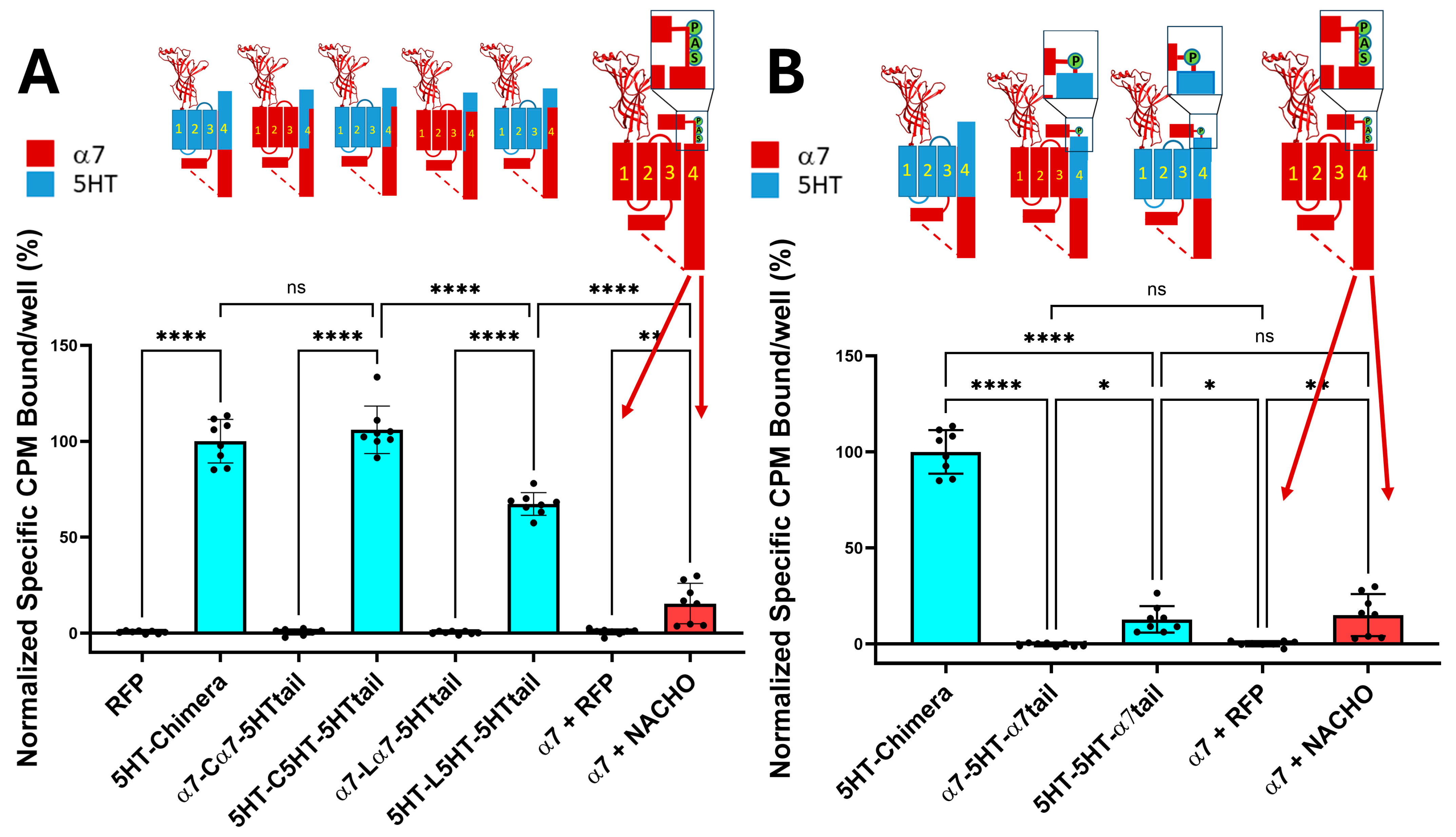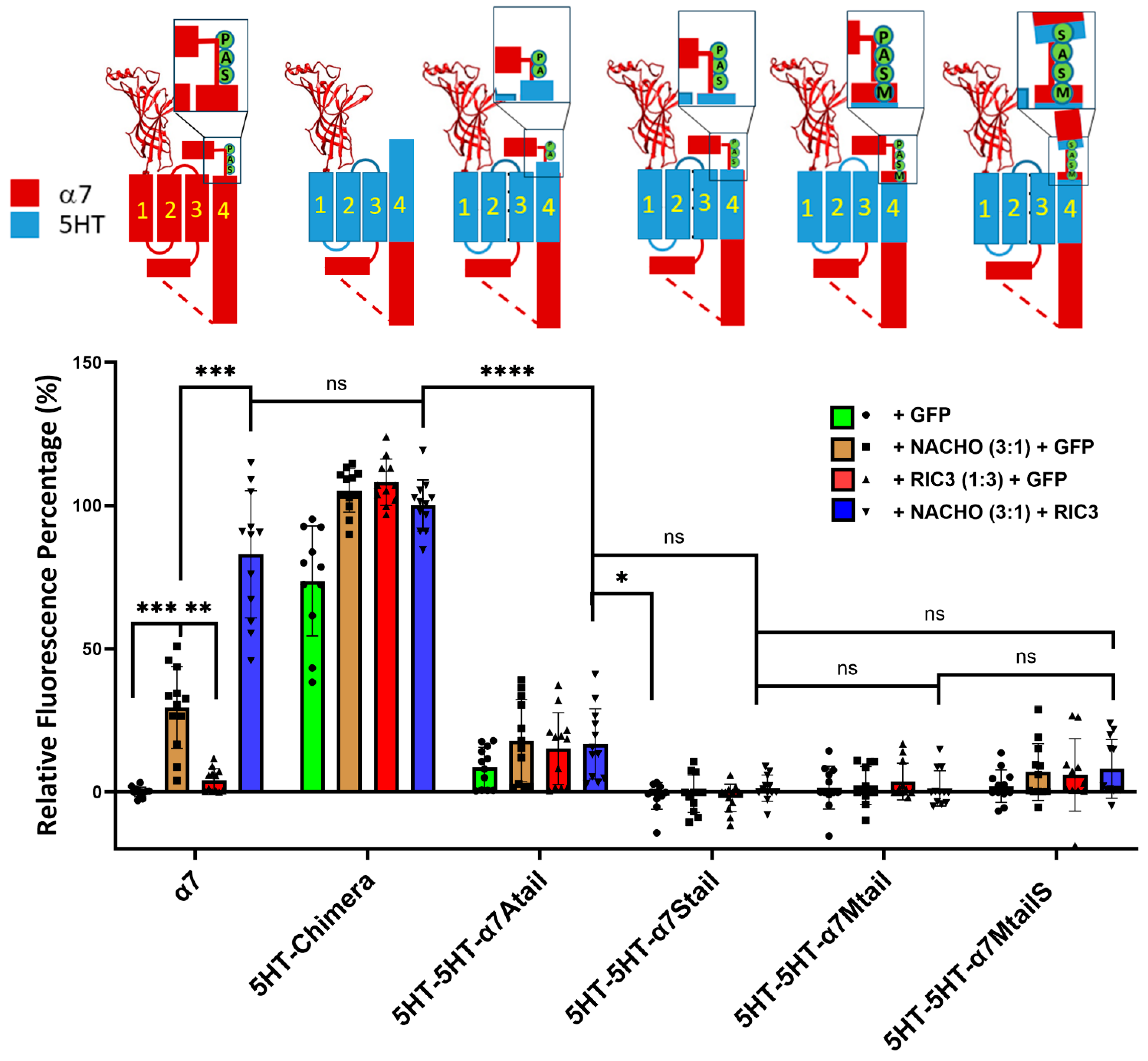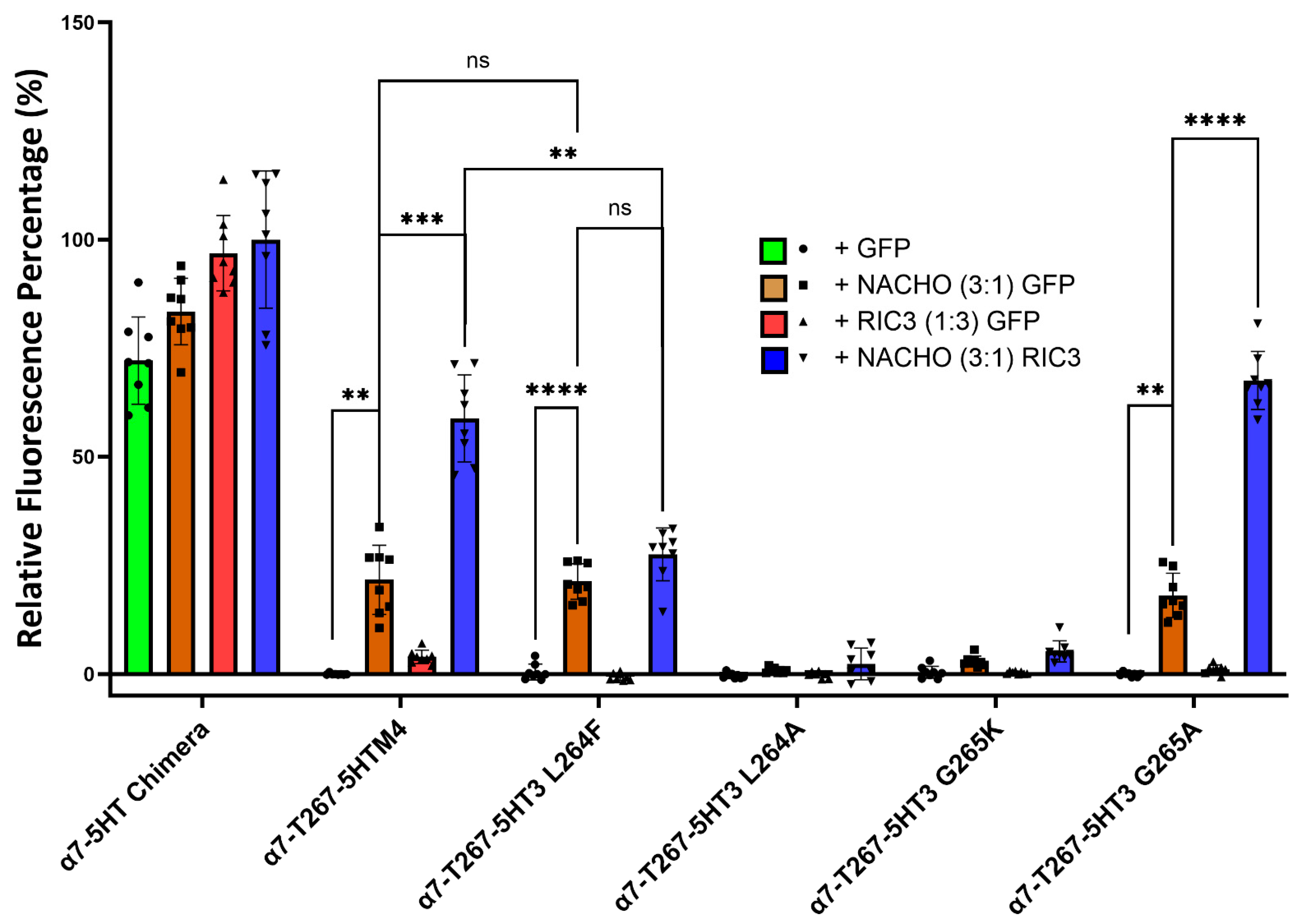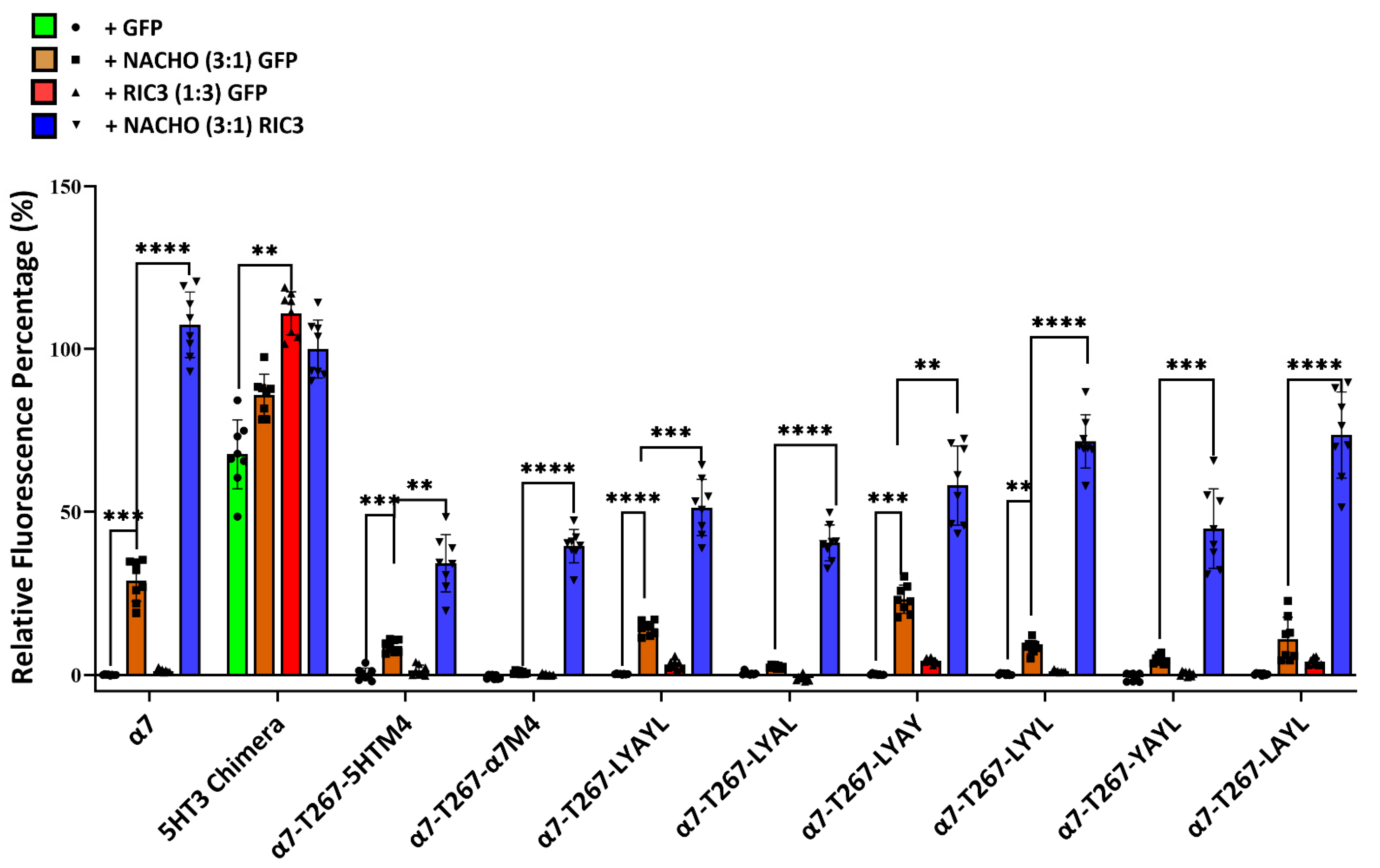Effects of Swapping 5HT3 and α7 Residues in Chimeric Receptor Proteins on RIC3 and NACHO Chaperone Actions
Abstract
1. Introduction
2. Results
2.1. Chimera Construction
2.2. α7 M4 and the α7 Tail are Important for NACHO and RIC3 Interactions
2.3. Quantification of Radioactive Binding Assay vs. Fluorescent Toxin Binding
2.4. Mixing M4 with Different TMs M1-M3 Does Not Allow for Plasma Membrane Expression, Even with Chaperones
2.5. Construct Expression in Oocytes
2.6. The SAP Motif Decreases Expression of 5HT3 TM Constructs
2.7. RIC3 Synergy is Enhanced with NACHO Interaction Within the α7 M1 and M2 Domains
3. Discussion
4. Materials and Methods
4.1. Bioinformatic Comparison and Molecular Modeling
4.2. DNA Constructs and Plasmids
4.3. Cell Lines
4.4. Reagents for Two-Electrode Voltage Clamp Electrophysiology Oocyte Recordings
4.5. Oocyte Preparation and cRNA Injection
4.6. Two-Electrode Voltage Clamp Electrophysiology
4.7. Transfections
4.8. Binding Assays
4.9. Fluorescent Binding Assays
4.10. Fluorescent Images Analysis Using ImageJ
5. Conclusions
- (1)
- A 5HT3 chimera consisting of the α7 N-terminal (to α7 V224 including the signal sequence), 5HT3 TMs 1-3, α7 ICD (α7 H319 to D468), and 5HT3 M4 + tail does not need additional chaperones to express in HEK293 or Bosc23 cells, unlike α7-nAChR (Figure 1 and Figure 2), corroborating previous reports by Gee et al. [13].
- (2)
- (3)
- In the 5HT3 chimera, substituting the 5HT3 tail (SIWHYS) with an α7 nAChR proline plus latch sequence (PNFVEAVSKDFA) allows some expression without the need for RIC3 or NACHO, but adding chaperones does not significantly change expression. This 5HT3-5HT-α7tail construct shows reduced cell surface expression in HEK293 and Bosc23 cells (relative to 5HT-chimera, Figure 1 and Figure 2) and function in oocytes (Figure 3). In oocytes it forms a functional receptor with current similar in amplitude of α7 nAChR (without chaperones). However, in the case when M4 is 5HT3 and TMs1-3 are α7, the resulting α7-5HT-α7tail construct does not express in HEK293 or Bosc23 cells (Figure 1 and Figure 2) and chaperones cannot rescue the expression (Figure 2). However, swapping 5HT3 residues for α7 to restore the SAP motif blocked expression and this could not be reversed with chaperones (Figure 4).
- (4)
- Our results corroborate Kweon et al. [20] that α7-T267-5HTM4 expresses with the help of NACHO and RIC3 but cast doubt on whether L264 and G265 are directly involved in NACHO action (Figure 5). A comparison of the ColabFold-AF2 predictions (Supplementary Figure S7) of α7-T267-5HTM4 (which requires NACHO for surface expression) and 5HT-5HT-α7tail (which does not but expresses (barely) in HEK and Bosc23 cells as well as in oocytes) suggests that the M1 sequence (α7 vs. 5HT3) or possibly the bottom half of M2 specifies whether NACHO is required for assembly. The same AlphaFold predictions imply that L264 and G265 are not located where they can easily interact with NACHO (Supplementary Figure S7), which is corroborated by the model of Hooda et al. [33] (Supplementary Figure S8).
- (5)
- We predicted that substituting an α7 M4 for 5HT3 in T267 constructs should not express, but instead we found that this construct does express with NACHO in the presence of RIC3 (Figure 6). Again, this suggests the bottom half of M2 specifies whether NACHO must be present for expression.
Supplementary Materials
Author Contributions
Funding
Data Availability Statement
Conflicts of Interest
References
- Overington, J.P.; Al-Lazikani, B.; Hopkins, A.L. How many drug targets are there? Nat. Rev. Drug Discov. 2006, 5, 993–996. [Google Scholar] [CrossRef]
- Millar, N.S.; Harkness, P.C. Assembly and trafficking of nicotinic acetylcholine receptors (Review). Mol. Membr. Biol. 2008, 25, 279–292. [Google Scholar] [CrossRef]
- Vallés, A.S.; Barrantes, F.J. Nicotinic Acetylcholine Receptor Dysfunction in Addiction and in Some Neurodegenerative and Neuropsychiatric Diseases. Cells 2023, 12, 2051. [Google Scholar] [CrossRef] [PubMed]
- Quik, M.; Zhang, D.; McGregor, M.; Bordia, T. Alpha7 nicotinic receptors as therapeutic targets for Parkinson’s disease. Biochem. Pharmacol. 2015, 97, 399–407. [Google Scholar] [CrossRef] [PubMed]
- Fontana, I.C.; Kumar, A.; Nordberg, A. The role of astrocytic α7 nicotinic acetylcholine receptors in Alzheimer disease. Nat. Rev. Neurol. 2023, 19, 278–288. [Google Scholar] [CrossRef] [PubMed]
- Matta, J.A.; Gu, S.; Davini, W.B.; Bredt, D.S. Nicotinic acetylcholine receptor redux: Discovery of accessories opens therapeutic vistas. Science 2021, 373, eabg6539. [Google Scholar] [CrossRef]
- Williams, M.E.; Burton, B.; Urrutia, A.; Shcherbatko, A.; Chavez-Noriega, L.E.; Cohen, C.J.; Aiyar, J. Ric-3 promotes functional expression of the nicotinic acetylcholine receptor alpha7 subunit in mammalian cells. J. Biol. Chem. 2005, 280, 1257–1263. [Google Scholar] [CrossRef]
- Gu, S.; Matta, J.A.; Lord, B.; Harrington, A.W.; Sutton, S.W.; Davini, W.B.; Bredt, D.S. Brain α7 Nicotinic Acetylcholine Receptor Assembly Requires NACHO. Neuron 2016, 89, 948–955. [Google Scholar] [CrossRef]
- Eisele, J.L.; Bertrand, S.; Galzi, J.L.; Devillers-Thiery, A.; Changeux, J.P.; Bertrand, D. Chimaeric nicotinic-serotonergic receptor combines distinct ligand binding and channel specificities. Nature 1993, 366, 479–483. [Google Scholar] [CrossRef]
- Craig, P.J.; Bose, S.; Zwart, R.; Beattie, R.E.; Folly, E.A.; Johnson, L.R.; Bell, E.; Evans, N.M.; Benedetti, G.; Pearson, K.H.; et al. Stable expression and characterisation of a human alpha 7 nicotinic subunit chimera: A tool for functional high-throughput screening. Eur. J. Pharmacol. 2004, 502, 31–40. [Google Scholar] [CrossRef]
- Quiram, P.A.; Sine, S.M. Identification of residues in the neuronal alpha7 acetylcholine receptor that confer selectivity for conotoxin ImI. J. Biol. Chem. 1998, 273, 11001–11006. [Google Scholar] [CrossRef]
- Halevi, S.; McKay, J.; Palfreyman, M.; Yassin, L.; Eshel, M.; Jorgensen, E.; Treinin, M. The C. elegans ric-3 gene is required for maturation of nicotinic acetylcholine receptors. EMBO J. 2002, 21, 1012–1020. [Google Scholar] [CrossRef]
- Gee, V.J.; Kracun, S.; Cooper, S.T.; Gibb, A.J.; Millar, N.S. Identification of domains influencing assembly and ion channel properties in alpha 7 nicotinic receptor and 5-HT3 receptor subunit chimaeras. Br. J. Pharmacol. 2007, 152, 501–512. [Google Scholar] [CrossRef] [PubMed]
- Koperniak, T.M.; Garg, B.K.; Boltax, J.; Loring, R.H. Cell-specific effects on surface α7 nicotinic receptor expression revealed by over-expression and knockdown of rat RIC3 protein. J. Neurochem. 2013, 124, 300–309. [Google Scholar] [CrossRef] [PubMed]
- Kuryatov, A.; Mukherjee, J.; Lindstrom, J. Chemical chaperones exceed the chaperone effects of RIC-3 in promoting assembly of functional α7 AChRs. PLoS ONE 2013, 8, e62246. [Google Scholar] [CrossRef]
- Deshpande, A.; Vinayakamoorthy, R.M.; Garg, B.K.; Thummapudi, J.P.; Oza, G.; Adhikari, K.; Agarwal, A.; Dalvi, P.; Iyer, S.; Thulasi Raman, S.; et al. Why Does Knocking Out NACHO, But Not RIC3, Completely Block Expression of α7 Nicotinic Receptors in Mouse Brain? Biomolecules 2020, 10, 470. [Google Scholar] [CrossRef]
- Loring, R.H. Speculation on How RIC-3 and Other Chaperones Facilitate α7 Nicotinic Receptor Folding and Assembly. Molecules 2022, 27, 4527. [Google Scholar] [CrossRef] [PubMed]
- Noviello, C.M.; Gharpure, A.; Mukhtasimova, N.; Cabuco, R.; Baxter, L.; Borek, D.; Sine, S.M.; Hibbs, R.E. Structure and gating mechanism of the α7 nicotinic acetylcholine receptor. Cell 2021, 184, 2121–2134.E13. [Google Scholar] [CrossRef]
- Zhao, Y.; Liu, S.; Zhou, Y.; Zhang, M.; Chen, H.; Eric Xu, H.; Sun, D.; Liu, L.; Tian, C. Structural basis of human α7 nicotinic acetylcholine receptor activation. Cell Res. 2021, 31, 713–716. [Google Scholar] [CrossRef]
- Kweon, H.J.; Gu, S.; Witham, E.; Dhara, M.; Yu, H.; Mandon, E.D.; Jawhari, A.; Bredt, D.S. NACHO Engages N-Glycosylation ER Chaperone Pathways for α7 Nicotinic Receptor Assembly. Cell Rep. 2020, 32, 108025. [Google Scholar] [CrossRef]
- Bondarenko, V.; Wells, M.M.; Chen, Q.; Tillman, T.S.; Singewald, K.; Lawless, M.J.; Caporoso, J.; Brandon, N.; Coleman, J.A.; Saxena, S.; et al. Structures of highly flexible intracellular domain of human α7 nicotinic acetylcholine receptor. Nat. Commun. 2022, 13, 793. [Google Scholar] [CrossRef]
- Borroni, V.; Barrantes, F.J. Homomeric and Heteromeric α7 Nicotinic Acetylcholine Receptors in Health and Some Central Nervous System Diseases. Membranes 2021, 11, 664. [Google Scholar] [CrossRef]
- Burns, L.H.; Pei, Z.; Wang, H.Y. Targeting α7 nicotinic acetylcholine receptors and their protein interactions in Alzheimer’s disease drug development. Drug Dev. Res. 2023, 84, 1085–1095. [Google Scholar] [CrossRef]
- Dineley, K.T.; Pandya, A.A.; Yakel, J.L. Nicotinic ACh receptors as therapeutic targets in CNS disorders. Trends Pharmacol. Sci. 2015, 36, 96–108. [Google Scholar] [CrossRef]
- Dineley, K.T. Beta-amyloid peptide--nicotinic acetylcholine receptor interaction: The two faces of health and disease. Front. Biosci. 2007, 12, 5030–5038. [Google Scholar] [CrossRef] [PubMed]
- Wang, H.Y.; Lee, D.H.; Davis, C.B.; Shank, R.P. Amyloid peptide Abeta(1-42) binds selectively and with picomolar affinity to alpha7 nicotinic acetylcholine receptors. J. Neurochem. 2000, 75, 1155–1161. [Google Scholar] [CrossRef] [PubMed]
- Uteshev, V.V. α7 nicotinic ACh receptors as a ligand-gated source of Ca2+ ions: The search for a Ca2+ optimum. Adv. Exp. Med. Biol. 2012, 740, 603–638. [Google Scholar] [CrossRef] [PubMed]
- Wu, M.; Liu, C.Z.; Barrall, E.A.; Rissman, R.A.; Joiner, W.J. Unbalanced Regulation of α7 nAChRs by Ly6h and NACHO Contributes to Neurotoxicity in Alzheimer’s Disease. J. Neurosci. 2021, 41, 8461–8474. [Google Scholar] [CrossRef]
- Halevi, S.; Yassin, L.; Eshel, M.; Sala, F.; Sala, S.; Criado, M.; Treinin, M. Conservation within the RIC-3 gene family. Effectors of mammalian nicotinic acetylcholine receptor expression. J. Biol. Chem. 2003, 278, 34411–34417. [Google Scholar] [CrossRef]
- Ben-Ami, H.C.; Biala, Y.; Farah, H.; Elishevitz, E.; Battat, E.; Treinin, M. Receptor and Subunit Specific Interactions of RIC-3 with Nicotinic Acetylcholine Receptors. Biochemistry 2009, 48, 12329–12336. [Google Scholar] [CrossRef]
- Wang, Y.; Yao, Y.; Tang, X.Q.; Wang, Z.Z. Mouse RIC-3, an endoplasmic reticulum chaperone, promotes assembly of the alpha7 acetylcholine receptor through a cytoplasmic coiled-coil domain. J. Neurosci. 2009, 29, 12625–12635. [Google Scholar] [CrossRef]
- Brockmöller, S.; Molitor, L.M.; Seeger, T.; Worek, F.; Rothmiller, S. N-Glycosylation Deficiency in Transgene α7 nAChR and RIC3 Expressing CHO Cells Without NACHO. J. Membr. Biol. 2024, 257, 245–256. [Google Scholar] [CrossRef]
- Hooda, Y.; Sente, A.; Judy, R.M.; Smalinskaitė, L.; Peak-Chew, S.Y.; Naydenova, K.; Malinauskas, T.; Hardwick, S.W.; Chirgadze, D.Y.; Aricescu, A.R.; et al. Mechanism of NACHO-mediated assembly of pentameric ligand-gated ion channels. bioRxiv 2024. [Google Scholar] [CrossRef]
- Mesoy, S.; Jeffreys, J.; Lummis, S.C.R. Characterization of Residues in the 5HT3 Receptor M4 Region That Contribute to Function. ACS Chem. Neurosci. 2019, 10, 3167–3172. [Google Scholar] [CrossRef]
- da Costa Couto, A.R.G.M.; Price, K.L.; Mesoy, S.; Capes, E.; Lummis, S.C.R. The M4 Helix Is Involved in α7 nACh Receptor Function. ACS Chem. Neurosci. 2020, 11, 1406–1412. [Google Scholar] [CrossRef] [PubMed]
- Lansdell, S.J.; Gee, V.J.; Harkness, P.C.; Doward, A.I.; Baker, E.R.; Gibb, A.J.; Millar, N.S. RIC-3 enhances functional expression of multiple nicotinic acetylcholine receptor subtypes in mammalian cells. Mol. Pharmacol. 2005, 68, 1431–1438. [Google Scholar] [CrossRef] [PubMed]
- Ito, R.; Ojima, H.; Takebayashi, M.; Takeuchi, M.; Takahashi, H.; Mori, S.; Ihara, M.; Sattelle, D.B.; Matsuda, K. Binding site loops D and G make a stronger contribution than loop C to the actions of neonicotinoids in the NACHO-assisted, robustly expressed Drosophila melanogaster Dα1/Dβ1 nicotinic acetylcholine receptor. Pestic. Biochem. Physiol. 2024, 209, 106325. [Google Scholar] [CrossRef]
- Hawkins, J.; Mitchell, E.L.; Jones, A.K. NACHO permits functional heterologous expression of an insect homomeric α6 nicotinic acetylcholine receptor. Pestic. Biochem. Physiol. 2021, 181, 105030. [Google Scholar] [CrossRef]
- Mesoy, S.M.; Lummis, S.C.R. M4, the Outermost Helix, is Extensively Involved in Opening of the α4β2 nACh Receptor. ACS Chem. Neurosci. 2021, 12, 133–139. [Google Scholar] [CrossRef]
- Altschul, S.F.; Gish, W.; Miller, W.; Myers, E.W.; Lipman, D.J. Basic local alignment search tool. J. Mol. Biol. 1990, 215, 403–410. [Google Scholar] [CrossRef]
- Yang, Z.; Lasker, K.; Schneidman-Duhovny, D.; Webb, B.; Huang, C.C.; Pettersen, E.F.; Goddard, T.D.; Meng, E.C.; Sali, A.; Ferrin, T.E. UCSF Chimera, MODELLER, and IMP: An integrated modeling system. J. Struct. Biol. 2012, 179, 269–278. [Google Scholar] [CrossRef]
- Meng, E.C.; Pettersen, E.F.; Couch, G.S.; Huang, C.C.; Ferrin, T.E. Tools for integrated sequence-structure analysis with UCSF Chimera. BMC Bioinform. 2006, 7, 339. [Google Scholar] [CrossRef] [PubMed]
- Pettersen, E.F.; Goddard, T.D.; Huang, C.C.; Couch, G.S.; Greenblatt, D.M.; Meng, E.C.; Ferrin, T.E. UCSF Chimera--a visualization system for exploratory research and analysis. J. Comput. Chem. 2004, 25, 1605–1612. [Google Scholar] [CrossRef]
- Pettersen, E.F.; Goddard, T.D.; Huang, C.C.; Meng, E.C.; Couch, G.S.; Croll, T.I.; Morris, J.H.; Ferrin, T.E. UCSF ChimeraX: Structure visualization for researchers, educators, and developers. Protein Sci. 2021, 30, 70–82. [Google Scholar] [CrossRef]
- Mirdita, M.; Schütze, K.; Moriwaki, Y.; Heo, L.; Ovchinnikov, S.; Steinegger, M. ColabFold: Making protein folding accessible to all. Nat. Methods 2022, 19, 679–682. [Google Scholar] [CrossRef] [PubMed]
- Kim, G.; Lee, S.; Levy Karin, E.; Kim, H.; Moriwaki, Y.; Ovchinnikov, S.; Steinegger, M.; Mirdita, M. Easy and accurate protein structure prediction using ColabFold. Nat. Protoc. 2024, 20, 620–642. [Google Scholar] [CrossRef] [PubMed]
- Jumper, J.; Evans, R.; Pritzel, A.; Green, T.; Figurnov, M.; Ronneberger, O.; Tunyasuvunakool, K.; Bates, R.; Žídek, A.; Potapenko, A.; et al. Highly accurate protein structure prediction with AlphaFold. Nature 2021, 596, 583–589. [Google Scholar] [CrossRef]
- Weltzin, M.M.; Lindstrom, J.M.; Lukas, R.J.; Whiteaker, P. Distinctive effects of nicotinic receptor intracellular-loop mutations associated with nocturnal frontal lobe epilepsy. Neuropharmacology 2016, 102, 158–173. [Google Scholar] [CrossRef]
- Garg, B.K.; Loring, R.H. GTS-21 has cell-specific anti-inflammatory effects independent of α7 nicotinic acetylcholine receptors. PLoS ONE 2019, 14, e0214942. [Google Scholar] [CrossRef]
- Schulz, D.W.; Loring, R.H.; Aizenman, E.; Zigmond, R.E. Autoradiographic localization of putative nicotinic receptors in the rat brain using 125I-neuronal bungarotoxin. J. Neurosci. 1991, 11, 287–297. [Google Scholar] [CrossRef]






| Construct Name | M1–M3 | M4—Latch/Tail Sequence |
|---|---|---|
| 5HT-chimera | 5HT3 | DRLLFRIYLLAVLAYSITLVTLWSIWHYS |
| 5HT-C5HT-5HTtail | 5HT3 | DRLLFSIYLVAVIIYSITLVMLWSIWHYS |
| 5HT-L5HT-5HTtail | 5HT3 | DRLLLMAYSVAVIIYTIGLLMLWSIWHYS |
| 5HT-5HT-α7tail | 5HT3 | DRLLFRIYLLAVLAYSITLVTLWPNFVEAVSKDFA |
| 5HT-5HT-α7Atail | 5HT3 | DRLLFRIYLLAVLAYSITLVTLAPNFVEAVSKDFA |
| 5HT-5HT-α7Stail | 5HT3 | DRLLFRIYLLAVLAYSITLVTSAPNFVEAVSKDFA |
| 5HT-5HT-α7Mtail | 5HT3 | DRLLFRIYLLAVLAYSITLVMSAPNFVEAVSKDFA |
| 5HT-5HT-α7MtailS | 5HT3 | DRLLFRIYLLAVLAYSITLVMSASNFVEAVSKDFA |
| α7-Cα7-5HTtail | α7 | DRLLFSIYLVAVIIYSITLVMLWSIWHYS |
| α7-Lα7-5HTtail | α7 | DRLLLMAYSVAVIIYTIGLLMLWSIWHYS |
| α7-5HT-α7tail | α7 | DRLLFRIYLLAVLAYSITLVTLWPNFVEAVSKDFA |
| α7-5HT-α7Atail | α7 | DRLLFRIYLLAVLAYSITLVTLAPNFVEAVSKDFA |
| α7-5HT-α7Stail | α7 | DRLLFRIYLLAVLAYSITLVTSAPNFVEAVSKDFA |
| α7-5HT-α7Mtail | α7 | DRLLFRIYLLAVLAYSITLVMSAPNFVEAVSKDFA |
| α7-5HT-α7MtailS | α7 | DRLLFRIYLLAVLAYSITLVMSASNFVEAVSKDFA |
| α7 | α7 | DRLCLMAFSVFTIICTIGILMSAPNFVEAVSKDFA |
| Construct Name | M4 & Tail |
|---|---|
| 5HT-chimera | DRLLFRIYLLAVLAYSITLVTLWSIWHYS |
| α7-T267-5HTM4 | DRLLFRIYLLAVLAYSITLVTLWSIWHYS |
| α7-T267-α7M4 | DRLCLMAFSVFTIICTIGILMSAPNFVEAVSKDFA |
| α7-T267-LYAYL | DRLLLMAYSVATIIYTIGLLMSAPNFVEAVSKDFA |
| α7-T267-LYAL | DRLLLMAYSVATIICTIGLLMSAPNFVEAVSKDFA |
| α7-T267-LYAY | DRLLLMAYSVATIIYTIGILMSAPNFVEAVSKDFA |
| α7-T267-LYYL | DRLLLMAYSVFTIIYTIGLLMSAPNFVEAVSKDFA |
| α7-T267-YAYL | DRLCLMAYSVATIIYTIGLLMSAPNFVEAVSKDFA |
| α7-T267-LAYL | DRLLLMAFSVATIIYTIGLLMSAPNFVEAVSKDFA |
| α7 | DRLCLMAFSVFTIICTIGILMSAPNFVEAVSKDFA |
| a7-T267-5HT3 G265A | DRLLFRIYLLAVLAYSITLVTLWSIWHYS |
| a7-T267-5HT3 L264A | DRLLFRIYLLAVLAYSITLVTLWSIWHYS |
| a7-T267-5HT3 G265K | DRLLFRIYLLAVLAYSITLVTLWSIWHYS |
| a7-T267-5HT3 L264F | DRLLFRIYLLAVLAYSITLVTLWSIWHYS |
Disclaimer/Publisher’s Note: The statements, opinions and data contained in all publications are solely those of the individual author(s) and contributor(s) and not of MDPI and/or the editor(s). MDPI and/or the editor(s) disclaim responsibility for any injury to people or property resulting from any ideas, methods, instructions or products referred to in the content. |
© 2025 by the authors. Licensee MDPI, Basel, Switzerland. This article is an open access article distributed under the terms and conditions of the Creative Commons Attribution (CC BY) license (https://creativecommons.org/licenses/by/4.0/).
Share and Cite
Yan, Z.; Oruganti, S.; Iyer, S.K.; Agarwal, K.; Gupta, M.; Adhikari, K.; Vijayan, N.; Doda, J.; Jain, V.; Lokhande, A.N.; et al. Effects of Swapping 5HT3 and α7 Residues in Chimeric Receptor Proteins on RIC3 and NACHO Chaperone Actions. Molecules 2025, 30, 4235. https://doi.org/10.3390/molecules30214235
Yan Z, Oruganti S, Iyer SK, Agarwal K, Gupta M, Adhikari K, Vijayan N, Doda J, Jain V, Lokhande AN, et al. Effects of Swapping 5HT3 and α7 Residues in Chimeric Receptor Proteins on RIC3 and NACHO Chaperone Actions. Molecules. 2025; 30(21):4235. https://doi.org/10.3390/molecules30214235
Chicago/Turabian StyleYan, Zixuan, Sreeharshini Oruganti, Swetha K. Iyer, Kushboo Agarwal, Mitali Gupta, Ketaki Adhikari, Nevetha Vijayan, Jash Doda, Vaishali Jain, Arya N. Lokhande, and et al. 2025. "Effects of Swapping 5HT3 and α7 Residues in Chimeric Receptor Proteins on RIC3 and NACHO Chaperone Actions" Molecules 30, no. 21: 4235. https://doi.org/10.3390/molecules30214235
APA StyleYan, Z., Oruganti, S., Iyer, S. K., Agarwal, K., Gupta, M., Adhikari, K., Vijayan, N., Doda, J., Jain, V., Lokhande, A. N., Nair, A. P., Nallanichakravarthula, V. S. K., Weltzin, M. M., & Loring, R. H. (2025). Effects of Swapping 5HT3 and α7 Residues in Chimeric Receptor Proteins on RIC3 and NACHO Chaperone Actions. Molecules, 30(21), 4235. https://doi.org/10.3390/molecules30214235









